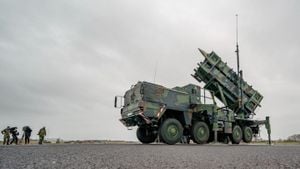The Indian Space Research Organisation (ISRO) celebrated another remarkable achievement on August 16, 2024, with the successful launch of its Earth Observation Satellite-8 (EOS-08) aboard the Small Satellite Launch Vehicle (SSLV)-D3. This launch marked the third and final developmental flight of the SSLV, solidifying India's capabilities in satellite deployment.
Launching from the Satish Dhawan Space Centre located in Sriharikota, the mission was initially set for August 15, but scheduling adjustments pushed the window to 9:17 AM on the 16th. Approximately 17 minutes post-liftoff, both EOS-08 and another satellite, DEMOSAT, were accurately positioned within their designated 475 km circular orbit.
ISRO Chairperson S. Somanath expressed triumph over the mission's success, stating, "It was a very successful mission... with the data available, the mission is almost 100% success with the satellite being placed in the correct orbit and all separation process happening nominally."
This milestone underscores ISRO's strategic effort to provide cost-effective access to space, which could potentially bolster future operational projects undertaken by the Indian industry and the NewSpace India Limited (NSIL). The SSLV is particularly noteworthy for its design, allowing for rapid launches—set to meet the rising global demand for small satellite launches.
The SSLV is compact, measuring just two meters wide and weighing 120 tonnes, and it can carry payloads of up to 500 kg. This contrasts sharply with India's heavier rockets; the GSLV Mk III, known as Bahubali, dwarfs it at 640 tonnes.
With the completion of SSLV-D3, ISRO aims to transition this technology for commercial use, facilitating launches for private companies. A memorandum of agreement has already been inked with several entities, indicating strong market interest.
Dr. M. Sankaran, Director of UR Rao Satellite Centre, referred to EOS-08 as "a trailblazing satellite packed with new futuristic technologies," illustrating its significance within India's space pursuits. The satellite carries three primary payloads: the Electro Optical Infrared Payload (EOIR), the Global Navigation Satellite System-Reflectometry payload (GNSS-R), and the SiC UV Dosimeter.
The EOIR payload is capable of acquiring images both day and night. Its deployment is anticipated to assist in comprehensive applications ranging from surveillance to monitoring natural disasters and industrial hazards.
Notably, the GNSS-R payload will explore advanced applications like ocean surface wind analysis, soil moisture detection, and tracking the Himalayan cryosphere. This showcases ISRO's commitment to utilizing satellite data for effective environmental monitoring.
The SiC UV Dosimeter serves dual functions by monitoring UV radiation and acting as an alarm for harmful gamma radiation. Its incorporation signals the importance of radiation monitoring for future missions, especially as India prepares for human space travel.
This SSLV flight also illustrated advancements present within industry frameworks. The SSLV development was finalized after extensive technological testing over seven years, culminating with costs exceeding Rs 170 Crore.
Space experts highlighted how the SSLV offers unmatched speed and cost-efficiency, capable of rapid assembly and launch preparation. This versatility positions the SSLV at the forefront of emerging small satellite markets, projected to reach $13.71 billion by 2030.
Speculation remains around ISRO pricing SSLV launches between Rs 30-35 Crore, inherently making it competitive on the global stage. Echoing this, GPIO and NewSpace officials believe the SSLV can propel India's space ambitions forward, serving commercial clientele efficiently.
Historical context is pivotal; SSLV-D3's two predecessors faced hurdles. SSLV's inaugural flight on August 7, 2022, encountered mishaps due to technical failures, leading to unsuccessful satellite placement.
Yet, from past trials emerged resilience; the subsequent SSLV-D2 mission on February 10, 2023, successfully launched three satellites, reaffirming ISRO’s expertise. The evolution of the SSLV through these victories exemplifies ISRO's nova determination to refine technology through rigorous application.
Indian industry’s involvement is escalated, with six companies eyeing SSLV technology transfer, slated to undertake their own missions. This transformative approach targets commercializing India's space sector, providing ample operational runway for both private and governmental space ambitions.
ISRO's successful launch of the EOS-08 emphasizes not only India’s growing prowess but also its dedication to innovative satellite technology. The agency continues to chart its ascent within global space exploration, deploying compact yet formidable launch vehicles to underscore its position as a leader on this front.



